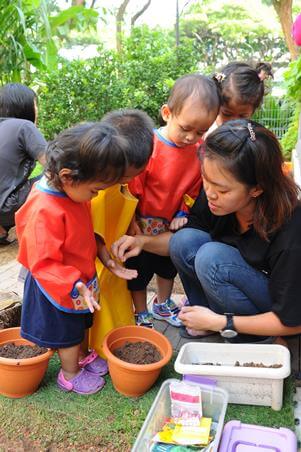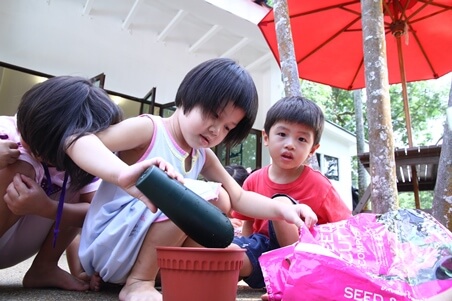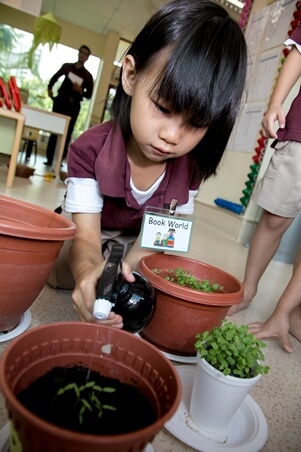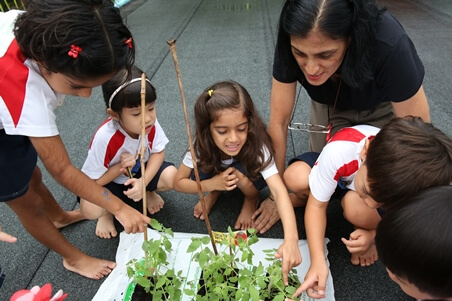The Circle of Life

Introducing your pre-schooler to the joys of science doesn't mean you have to buy specialised equipment or toys. There are plenty of activities that only require materials easily sourced from the neighbourhood market. You might even have what you need at home!
For example, spare cardboard boxes can serve as rocket ships for a day spent exploring the universe. Or you can turn an old wire clothes hanger and a bucket of soapy water into a fun lesson on blowing bubbles.
A perennial favourite among children, however, is simply growing things. And you don't need a garden to introduce your child to the pleasures of mucking about in the dirt. All you need is a sunny corner (where you'd hang your laundry, for example) and some common household materials. You don't even need soil unless you start getting serious about gardening.

What's more, growing something simple - such as a small bean plant - opens up a new window of opportunity to talk about many areas of science and math. You child can learn analytical skills such as measuring, charting data and comparing/ contrasting. Or you can discuss the many aspects of the natural world - the life cycle of a plant, the water cycle, nutrition, growth and more!
To get started, read on!
GROW YOUR OWN BEANS

Materials:
- A glass jar (an empty jam jar that has been rinsed clean is perfect)
- Some cotton balls
- Some beans (mung beans, red beans, butter beans - whatever tickles your child's fancy)
Optional learning materials:
- Notebook
- Camera
- Ruler
- Pencil
Method:
1) Pack the glass jar with cotton balls.
2) Plant your beans between the cotton balls and the side of the jar. This way, you will be able to see how the bean germinates and grows. Plant at least two or more.
3) Water the cotton balls until they are damp but not soaking wet.
4) Put the jar in a warm sunny spot - a kitchen window is ideal.
5) Wait and observe!
DIARY OF A BEAN
Here is what you can expect:
- The bean should start sprouting a small root.
- The small root should start sprouting little hairs or tendrils.
- Look for a large network of roots growing off the main root.
- Then, a sturdy stem should appear.
- Watch for the first set of leaves!
LEARNING ACTIVITIES
One way to track the bean's progress is to make a "bean diary". Explain how to use a ruler, and help your child to measure the growth of bean and record its progress. If you have a camera, take a picture and print it out to include in the bean diary. Ask your child to compare and contrast the various stages of bean development.
There's plenty of ways to boost your child's understanding of the natural world with this activity. Here are a few topics you can cover:
- What do plants need to grow? Discuss air, water, sunshine and ask your child why plants need those things. Compare the needs of a plant to the needs of other living things (such as animals or humans).

- How does a plant get its water/ air/ sunshine? Talk about roots and leaves. Point out to your child the root system that is slowly establishing itself - note the small hairs growing on each baby root. Show your child how leaves are designed to maximise the amount of sunshine they can absorb.

- How does a plant grow? Talk about the life cycle of a plant. Explain what will happen to the bean plant after it grows. Will it flower? Bear fruit? Compare the early development of the bean plant from seed to seedling to the development of a baby into a toddler - you can use pictures of your child to illustrate the differences.
- If your child is older, consider making a growth chart to track the bean's development using the measurements you have obtained. This is a great way to introduce the concept of height, measurements and simple math ideas.
Most importantly, don't just lecture your child on the topics above. As you go along, encourage him to ask his own questions and create his own journey of discovery.
EXTENSION ACTIVITIES
If your child enjoyed growing a few beans, here's what you can do next:
- Transplant the bean seedlings into a proper pot to watch them grow further. Who knows? You might get a few more beans of your own! Make sure you use good, well-drained potting soil and that you water/ fertilize frequently. Possible discussion topics include nutrition and hydration.
- Try the same experiment with different beans. Compare growth rates and heights.
- Or try growing the same bean, but vary the growing conditions. Put a jar in the fridge, in an air-conditioned room, or in a dark cupboard. Compare and contrast the results.
You may also like

From Cabin to Classroom: Journey of an Outstanding Early Childhood Educator
The PDP modules allowed me to get creative with lesson ideas and keep up with the ever-changing Early Childhood sector.

Ms Farhana Binte Mohamed Hassan
Early Years Educator - PCF Sparkletots @ Pioneer Block 987D (CC)

More Than Just a Place for Food
Young children are highly inquisitive, and learn most effectively with activities that allow exploration and experimentation.

Kinderland @ Yio Chu Kang

Little Fingers Create Great Art - A Community Project by Kinderland and Skool4kidz
I believe this collaborative effort is a very meaningful contribution to the SG50 celebrations.

Kinderland and Skool4Kidz